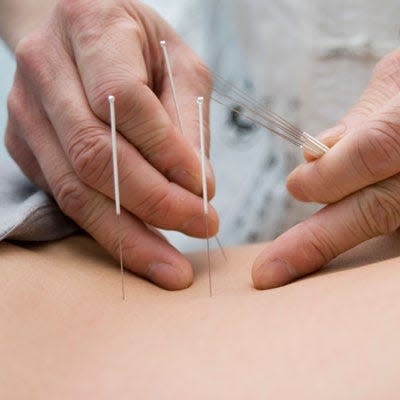Persistent pain? Needles can help relieve the discomfort
Frequent headaches, nagging lower back pain, tennis elbow, or whiplash from a car accident. These are all conditions in which dry needling can effectively treat. Treatment with a needle sounds painful and a little intimidating, but dry needling has become a commonly used therapy for people who are experiencing muscle, ligament or tendon pain that other therapies may not seem to relieve.
Dry needling is done by physical therapists, occupational therapists and acupuncturists who have special training and certification in the technique. Most people who use dry needling as part of a treatment plan report little to no discomfort during the treatments.

Dry needling is becoming a popular tool in physical therapy as it effectively treats many musculoskeletal issues such as headaches, whiplash, plantar fasciitis, low back pain, muscle strains and tears, TMJ disorders, chronic pain and many other issues. Dry needling is the use of a monofilament needle inserted into a targeted area of muscle or tissue for a set amount time.
A monofilament needle is a very thin needle that is inserted into the skin with little to no pain. The needles are much thinner than those used for shots and are never used as a means of injecting medication in to the tissues.
Trigger points, or the precise areas where pain is felt, disrupt the proper function of the muscle, restrict range of motion or cause pain and tenderness. Physical therapists or licensed acupuncturists will complete an in-depth evaluation to determine if dry needling is appropriate for each patient
The therapist will discuss exact symptoms and assess mobility to identify if trigger points are the cause of the pain being experienced. If appropriate, dry needling can then be used on the identified trigger points to assist in the relief of the pain.
How does dry needling work?
The monofilament needle is inserted in the muscle or tissue that is restricted and causing pain. The needles remain inserted in the area approximately 10 to 20 minutes, depending on the treatment area and the amount of needles used during the therapy session.
Denée Trosterud, UH Samaritan’s outpatient therapy supervisor says: The needle is not filled with medicine and does not inject any solution into the muscle, hence the term “dry needling.” Inserting the needle causes the muscle to twitch, which in turn releases the trigger point (or knot) in the tissue. The improved circulation to the tissue brings more blood flow and oxygen to the area. It also releases neurochemicals which allow for proper functioning of the tissue, and assists in pain relief.
Dry needling affects people differently. Most patients report immediate relief of pain with treatment. Some report euphoria, increased warmth in the area treated, or decreased tension/tightness. Physical therapy and other exercise programs are used in conjunction with dry needling to be sure the trigger areas are relieved and do not cause recurring pain.
University Hospitals Samaritan Medical Center’s outpatient Physical Therapy department has several therapists who are certified in dry needling. If you or someone you know are interested, call the UH Samaritan Rehabilitation Center at 419-281-1330 for more information on scheduling a session with a therapist.
Christina Vanderpool is the community outreach and communications and development specialist at University Hospitals Samaritan Medical Center in Ashland.
This article originally appeared on Ashland Times Gazette: Dry needling can help with a variety of pain headache whiplash,
